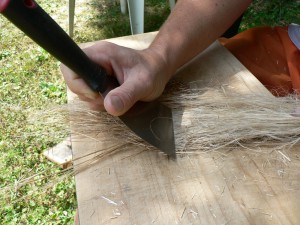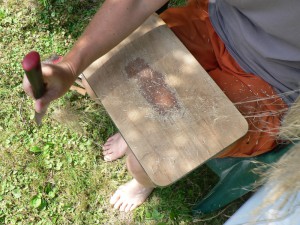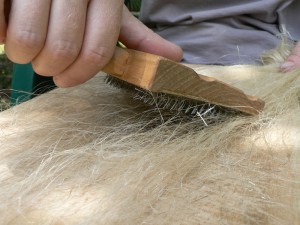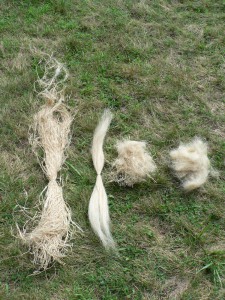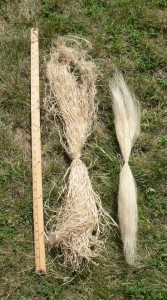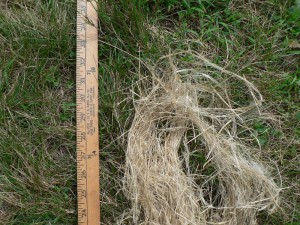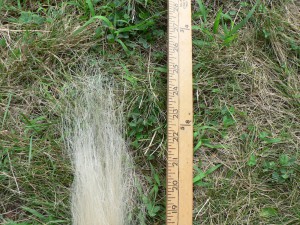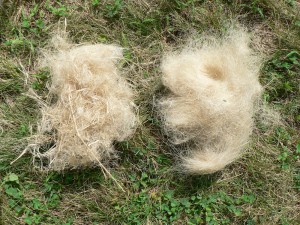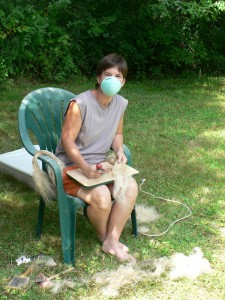At long last, I have been processing some of my stash of retted and broken flax. This process is traditionally called dressing, though I am not using traditional tools or techniques. However, I am having success using a variation on a method that Chris Hammel (12/24/2023 link updated) showed me, which utilizes tools from the kitchen and hardware store, and other tools that a fiber person might have lying around the apartment.
Many of these bundles I believe were under-retted, which makes it hard to clean them. On the other hand, it’s not impossible, and I am feeling relieved not to have ruined several years’ worth of fiber.
First, I “scutch” with a flexible 3 inch putty knife on an old wooden cutting board.
All the small branches at the top break right off at this point. I’m not sure how useful they might be for other projects because they are still attached to the woody parts of the plant and I think they would be really hard to clean. I scrape them onto the ground. Some I put into the compost, and some I save in a bag for the time being. The photo below shows a clump of tow falling to the ground.
I actually split my bundles into two or three sections for dressing. The size I originally tied when I harvested, which seemed fine for drying and retting, is too thick to handle all at once. I start at the branchy end of the mini-bundle first, then work down toward the middle. Then I flip it over, start at the root end, and work toward the middle. The middle is the hardest part to clean because the fibers are denser here. I spread it out into as thin a layer as I can and scrape and scrape. This part takes a long time.
Next, I use a spiky comb-like tool that I bought at Leader Hardware here in Amherst (12/24/2023 Now Ace/Hamshaw). I don’t know what its real function is supposed to be, but it works very well as my “rough hetchel.” Chris says she uses a metal dog comb, which is probably similar. I like the fact that mine is spiky. I don’t know if the spikes really help or not, but I still like it.
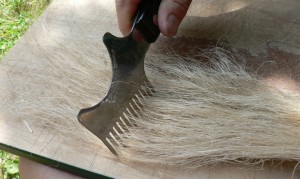 Quite a lot of tow (the short fibers) comes out in this step of the process, also, but it is cleaner than the stuff that comes off in the “scutching” stage, with much less woody material in it. I can definitely imagine carding and spinning the “hetcheling” tow. Sometimes after this stage I notice more, very fine, woody bits clinging to the fibers and go back and scrape some more.
Quite a lot of tow (the short fibers) comes out in this step of the process, also, but it is cleaner than the stuff that comes off in the “scutching” stage, with much less woody material in it. I can definitely imagine carding and spinning the “hetcheling” tow. Sometimes after this stage I notice more, very fine, woody bits clinging to the fibers and go back and scrape some more.
Next, I use a regular wool carder for the “fine hetchel.” I have used both a Schacht mini-carder and an Ashford flick carder. I decided that I prefer the flick-carder because it has a nice smoothing action on the fibers that makes them more glossy and a little softer. But it’s the Schacht in the photo.
This photo shows me scraping down against the board, which is the first step in the process. Then I lift up the bundle and brush it over my gripped fingers like a pony-tail.
A large quantity of material is lost in this process. A lot of woody material that I don’t save, and various grades of tow. I have been saving the two cleaner-looking grades.
Here you can see a bundle that was broken next to the amount of “line” or long fibers that an equivalent bundle generated. On the right are the two grades of tow that I saved from that bundle.
Here’s a yard stick for comparison:
Above is the length of the broken bundle (between 34 and 35 inches) and below, the length of line I obtained from a comparable bundle (between 25 and 26 inches):
Not all the line fibers will be 26 inches long, but that’s the longest.
Above are the two grades of tow I’ve been saving. You can see that the one on the left has more woody material in it. It may not prove to be worth saving, in the end, I’ll have to wait and see.
This process is extremely dusty, and even though I do it outside I wear a mask.
So far I have processed 9 bundles from 2008 and 2010. The weather has been glorious for this work: very sunny and very dry. It is very hard to scutch when it is humid, as the fiber clings to the woody material and doesn’t let go. Basically it is a waste of time. It’s like that joke about teaching a pig to sing. So, I plan to dress as much as I can while the weather holds, then switch to spinning when it gets humid again. I’m not saying I don’t love this weather, but we do need some rain.

